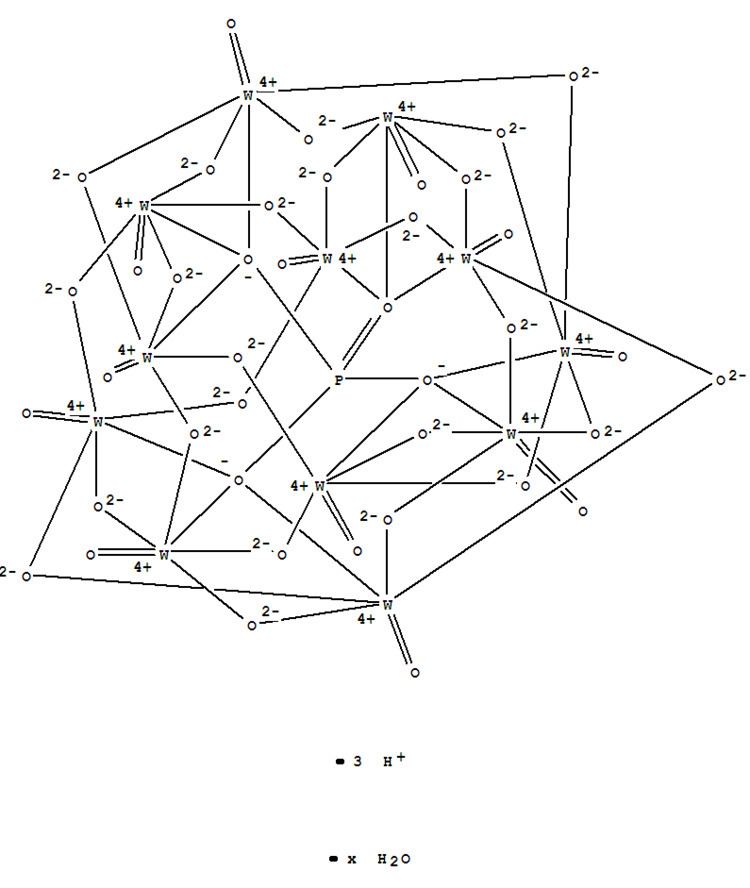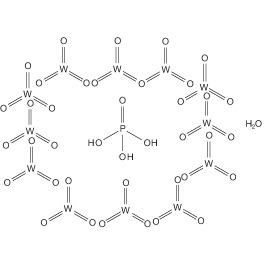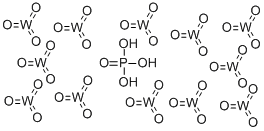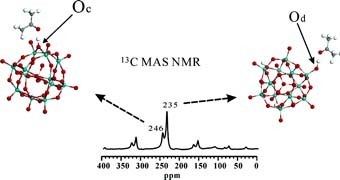Molar mass 2,880.2 g/mol Melting point 89 °C | Formula H3PW12O40 | |
 | ||
Phosphotungstic acid (PTA), tungstophosphoric acid (TPA), is a heteropoly acid with the Chemical formula H3PW12O40. It is normally present as a hydrate. EPTA is the name of ethanolic phosphotungstic acid, its alcohol solution used in biology. It has the appearance of small, colorless-grayish or slightly yellow-green crystals, with Melting point 89 °C (24 H2O hydrate). It is odorless and soluble in water (200 g/100 ml). It is not especially toxic, but is a mild acidic irritant. The compound is known by a variety of different names and acronyms (see 'other names' section of infobox).
Contents
- Structure
- Preparation and chemical properties
- Catalyst
- Dyeing and pigments
- Histology
- Analysis
- Precipitation of proteins
- Medicinal
- Composite proton exchange membranes
- References

In these names the "12" or "dodeca" reflects the fact that the anion contains 12 tungsten atoms. Some early workers who did not know the structure, such as Hsien Wu, called it phospho-24-tungstic acid, formulating it as 3H2O.P2O5 24WO3.59H2O, (P2W24O80H6).29H2O, which correctly identifies the atomic ratios of P, W and O. This formula was still quoted in papers as late as 1970.

Phosphotungstic acid is used in histology as a component for staining of cell specimens, often together with haematoxylin as PTAH. It binds to fibrin, collagen, and fibres of connective tissues, and replaces the anions of dyes from these materials, selectively decoloring them.

Phosphotungstic acid is electron dense, opaque for electrons. It is a common negative stain for viruses, nerves, polysaccharides, and other biological tissue materials for imaging by a transmission electron microscope.

Structure

Gouzerh summarises the historical views on the structure of phosphotungstic acid leading up to Keggin's determination of the structure as:
The structure was determined by J.F Keggin first published in 1933 and then in 1934 and is generally known as the Keggin structure. The anion has full tetrahedral symmetry and comprises a cage of twelve tungsten atoms linked by oxygen atoms with the phosphorus atom at its centre. The picture on the right shows the octahedral coordination of oxygen atoms around the tungsten atoms, and that the surface of the anion has both bridging and terminal oxygen atoms. Further investigation showed that the compound was a hexahydrate not a pentahydrate as Keggin had proposed.
Preparation and chemical properties
Phosphotungstic acid can be prepared by the reaction of sodium tungstate, Na2WO4.2H2O, with phosphoric acid, H3PO4, acidified with hydrochloric acid, HCl.
Phosphotungstic acid solutions decompose as the pH is increased. A step-wise decomposition has been determined and the approximate compositions at various pH values are as follows:
The species [PW11O39]7− is a lacunary, or defective Keggin ion. The [P2W18O62]6− has a Dawson structure. At pH less than 8, the presence of ethanol or acetone stabilises the anion, [PW12O40]3−, reducing decomposition.
Tungstophosphoric acid is thermally stable up to 400 °C, and is more stable than the analogous silicotungstic acid, H4SiW12O40.
Large quantities of polar molecules such as pyridine are absorbed into the bulk phase and not simply on the surface. Solid state NMR studies of ethanol absorbed in the bulk phase show that both protonated dimers, ((C2H5OH)2H+) and monomers, (C2H5OH2+) are present.
Phosphotungstic acid is less sensitive to reduction than Phosphomolybdic acid. Reduction with uric acid or iron(II) sulfate produces a brown coloured compound. the related silicotungstic acid when reduced forms a similar brown compound where one of the four W3 units in the Keggin structure becomes a metal-metal bonded cluster of three edge shared W(IV) octahedra.
Phosphotungstic acid is the strongest of heteropolyacids. Its conjugate base is the PW12O403− anion. Its acidity in acetic acid has been investigated and shows that the three protons dissociate independently rather than sequentially, and the acid sites are of the same strength. One estimate of the acidity is that the solid has an acidity stronger than H0 =−13.16, which would qualify the compound as a superacid. This acidic strength means that even at low pH the acid is fully dissociated.
Catalyst
In common with the other heteropolyacids phosphotungstic acid is a catalyst and its high acidity and thermal stability make it a catalyst of choice according to some researchers. It is in solution as a homogeneous catalyst, and as a heterogeneous catalyst "supported" on a substrate e.g. alumina, silica. Some acid catalysed reactions include:
Dyeing and pigments
Phosphotungstic acid has been used to precipitate different types of dyes as "lakes". Examples are basic dyes and triphenylmethane dyes, e.g. pararosaniline derivatives.
Histology
Phosphotungstic acid is used in histology for staining specimens, as a component of phosphotungstic acid haematoxylin, PTAH, and “trichrome” reagents, and as a negative stain for imaging by a transmission electron microscope.
Analysis
The potassium salt is only slightly soluble, unlike most other phosphotungstate salts, and has been proposed as a method for the gravimetric analysis of potassium.
Precipitation of proteins
In a number of analytical procedures one of the roles of phosphotungstic acid is to precipitate out proteins. It has been termed a "universal" precipitant for polar proteins. Further studies showed that no precipitation occurred with α-amino groups but did occur with guanidino, ε-amino and imidazole groups.
Medicinal
Very little work appears to have been carried out in this area. One example relates to liver necrosis in rats.
Composite proton exchange membranes
The heteropoly acids, including phosphotungstic acid, are being investigated as materials in composite proton exchange membranes, such as Nafion. The interest lies in the potential of these composite materials in the manufacture of fuel cells as they have improved operating characteristics.
